This was published 8 years ago
Rajasthan, India: Touring India's most exotic state in the lap of luxury
By Brigid Delaney
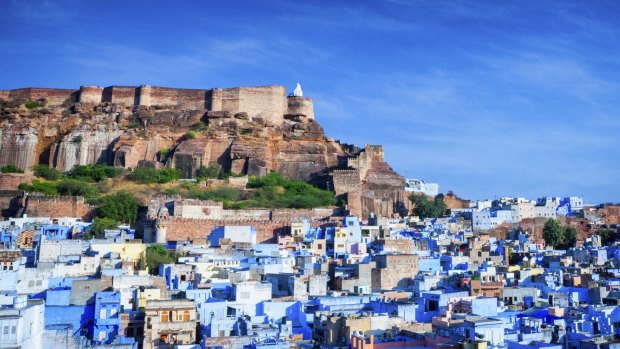
Cityscape of Blue City and Mehrangarh Fort - Jodhpur.Credit: iStock
There's a lot to unpack about India – most of all the preconceptions. I'd lumped it in under hard travel – a place of dusty, oppressive heat, poverty, where everything is difficult. And Rajasthan? A land of snake charmers – exotic, dangerous, mystical, impenetrable, beautiful.
But travel to India can be beautifully and extravagantly luxurious.
Rajasthan is India's largest and most northern state, bordering Pakistan. It's the land of kings and maharajahs, of polo fields and drinks poured from art deco martini shakers, of four-poster beds and swimming pools in the desert.
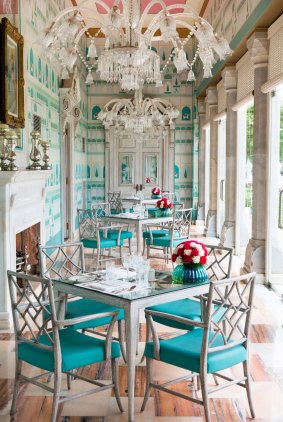
Rajmahal Palace, Relais & Chateaux. The Colonnade Dining Room.
Those polo-playing maharajahs left behind beautiful, intricate palaces and forts. The buildings, in pink and gold sandstone, play off the beautiful desert light. It's an Instagrammer's dream.
Then there are the Rajasthan people – hospitable, joyful, friendly and dressed in iridescent saris and turbans – whizzing about on motorbikes or walking at the pace of goats as they bring a herd along the dusty back roads.
You'll need around two weeks to see the highlights of Rajasthan. I had eight days. Here's what we saw.
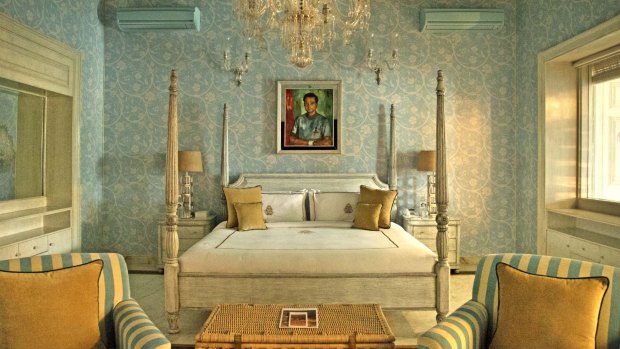
Sujan Rajmahal Palace in India's Pink City, Jaipur.
JODHPUR
After a night in Delhi we fly to Jodhpur, the second-largest city in Rajasthan, at the entrance to the Thar Desert. The indigo washes of the houses give it its evocative hue and name, the Blue City.
The Mehrangarh Fort, circa 1459, overlooks the city and is a must-see. We stop for lunch at Umaid Bhawan Palace. It's my first taste of an Indian palace and my jaw is on the (marble) floor. Then it's on to the fort, which Rudyard Kipling called "the work of giants". It looms over the blue neighbourhoods and the desert, standing more than 30 metres on a cliff face above the skyline of Jodhpur. It has a crumbling, haunting beauty. Our guide tells us the fort was once home to a dynasty of Rajput rulers. There are still cannonball marks on the walls and, as you reach Lohapol gate, 15 tiny handprints – self-immolation marks, of maharajah Man Singh's widows, who threw themselves on his funeral pyre in 1843.
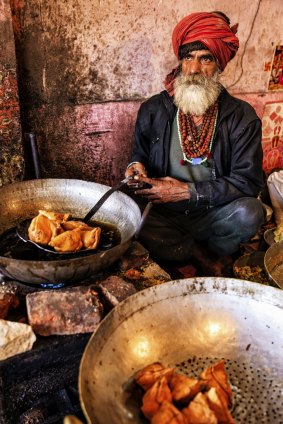
Indian street vendor.Credit: iStock
After several hours at the fort we take a rickshaw through the old walled city. The streets are narrow and bustling. It's the Ganesh festival and there are neon elephants, music and strings of pulsating fairylights everywhere. We careen around the windy, medieval, atmospheric streets packed with spice sellers, chai vendors, groups of school children and families out shopping.
We check into the Raas Hotel in Jodhpur before heading to a neighbourhood haveli for a cultural performance and food.
A word on Rajasthani food: it is delicious and you should eat everything on your plate, then go on a diet after you have left India.
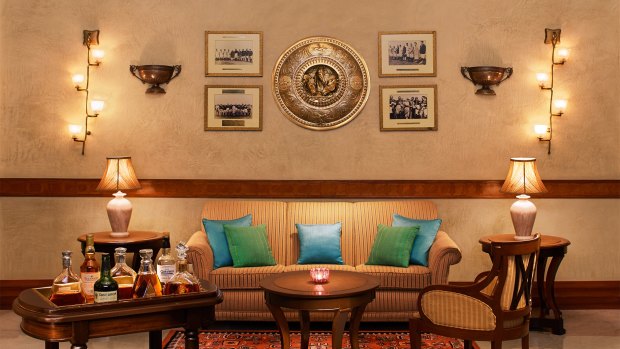
Rambagh Palace, Jaipur.
A typical meal starts with snacks (samosa or pappadams, crispy and hot from the pan), before curries and naan to share. A proper Rajasthan curry (usually a selection of chickpea, dhal, tandoori and chicken on a metal plate) is eaten scooped up in naan still warm from the oven – and is a reason in itself to travel here.
Foodie highlights from India are plenty: a chai in rural India, sipped from a paper cup with local schoolchildren; a scooped-up chicken curry on bread; sitting outside in the courtyard of a haveli on a hot night snacking on discs of yoghurt that had been hung and dried before being pan fried; the beer; tandoori chicken and mutton in clay spices; cold soups including an incredibly cooling, delicate pink watermelon and pepper soup. As for "Delhi belly", I didn't get sick at all during my time in India.
Next morning we're off on a wilderness safari run by the Rohet Garh hotel, which has been taking people out since 1989. Although I'm keen on wildlife (we see bison and some incredible birdlife), it's people I want to meet.
We stop at a small village and meet a Brahmin priest and sit on the floor of his house while an opium drink is prepared. The opium ceremony is still practised in these isolated parts. A ball of opium is crushed, put through a sieve and mixed with water. The watery, milky-coloured liquid is then slurped from the hands of the Brahmin priest. It tastes a bit like ouzo and, I've got to say, I did not feel high.
We visit the mud-brick home of a Bishnoi farmer (the Bishnoi, prevented from killing animals and felling trees, are the custodians of the environment in the region), and then it's lunch at an exquisite boutique hotel in the desert, the Relais and Chateaux Mihir Garh.
This new hotel (described in one review as a "fantasy fort") has nine rooms – and is run by an equestrian-mad local family who take horse-riding outings across the desert.
SHAHPURA
After lunch it's a seven-hour drive to Shahpura, where we stay at the summer house of former rulers (everyone seems to be related to the royal family in Rajasthan). The hotel is set on 45 hectares, surrounded by stunning lakes that teem with birdlife in the cooler months. It is Rajasthan meets colonial chic. At dinner we are served delicious Rajasthan home cooking and the next morning we're on the road again to Jaipur – the Pink City.
There's plenty to see on the road: men in orange turbans; people on motorcycles carrying a large load of logs; the many tuk-tuks with "horn please" in curvy, colourful circus script; schoolchildren in impossibly white uniforms; skinny cows crossing the road; trucks packed with people, tinsel and Christmas lights; women with their faces covered in bright silks; men asleep in doorways that open out onto roads; roadside barbershops; men ironing outside on large pieces of stone.
JAIPUR
The Pink City is the capital of Rajasthan, a spectacular, magical city (one of our first sights is a man riding an elephant through the main street), with many of its buildings constructed using pink bricks.
Our lodgings – the newly refurbished Raj Mahal Palace – are wonderful; India deco meets Palm Springs, the hot-pink breakfast room inspired by a Vogue cover from the 1950s.
The Palace Hotel, another beautifully restored palace run by the Taj Hotel group, is well worth a visit for cocktails. We had the gorgeous, pink Jaipur martini. The Polo Lounge bar is something out of Somerset Maugham, with old polo sticks on the wall and stripy silk billowing like a tent from the roof.
We have two afternoons shopping at the hectic Johari Bazaar, where we stock up on everything from shoes to quilts and shawls. Jaipur is known for its antiques, jewellery, textiles and leather.
But it is the Amer Fort that is the must-see attraction in the city. Built in the 11th century, it's been expanded as successive dynasties have moved in – and is now a visually breathtaking fortress town.
Like the fort in Jodhpur, it is perched spectacularly on a hill overlooking the city. We are taken up to the top of the fort on an elephant's back – with touts following us all the way trying to sell us trinkets.
A guide takes us through the four courtyards, where the history of the fort has been preserved and told through ceiling paintings, side panels, domes and colonnades. The museum is fascinating – with ancient weapons and old costumes belonging to former maharajahs.
The next day we drive on through the countryside – towards the spectacular Aravalli mountain range for two nights at Amanbagh, a Rajasthani retreat inspired by Mughal style and run by the super-posh Aman hotel group. It's a perfect way to end the trip and reflect on the mad, exciting, wonderful week.
TRIP NOTES
MORE INFORMATION
www.pureindiacollection.com.au
GETTING THERE
Air India flies daily from Australia to New Delhi; from Sydney four times a week, Melbourne three times.
Return economy flights start at $1227. See airindia.in. The best times to go are March to November. The Pure India Collection arranged a driver and a minivan with Wi-Fi. They also booked flights from Delhi to Jodhpur – with porters included.
STAYING THERE
The Pure India Collection and local partners Secrets of India Collection arranged all accommodation and transfers. The price includes meals, transport, guides, entrance to monuments, excursions including an elephant ride at Amer Fort and village safari in Rohet and Ramathra fort.
TOURING THERE
Based on the shorter itinerary for eight nights, the price is $2499 a person twin share (not including flights). If you want to upgrade to two nights at Amanbagh the supplement is $1340 a person.
The Pure India Collection has also organised two small group tours (maximum of 12) for 12 nights – staying in luxury hotels and including a visit to the Taj Mahal ($6760 based on twin share including all the tours, sightseeing and most meals). Group departures in March and September 2016.
Brigid Delaney travelled through India courtesy of the Pure India Collection and flew courtesy of Air India.
Sign up for the Traveller Deals newsletter
Get exclusive travel deals delivered straight to your inbox. Sign up now.